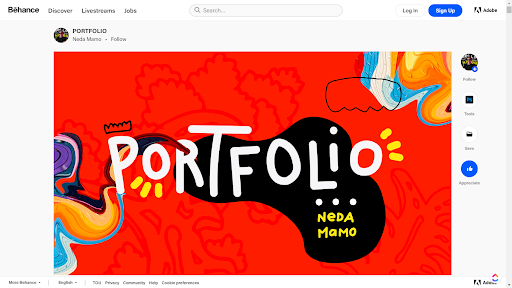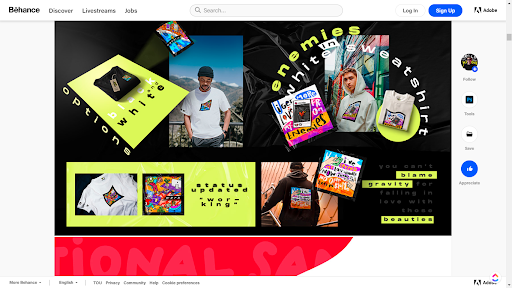The Freelancer’s Definitive Guide to Creating a Killer Online Portfolio
Over the last 12 years, I have cracked the code on the do’s and don’ts of an online portfolio. Are you ready for the first surprising insight?
Your online portfolio isn’t as important as you think.
Before you hang me for treason, hear me out.
The biggest mistake most freelancers and consultants make is overvaluing their hard skills, meaning the ones represented in their online portfolios. At the same time, we tend to undervalue other skills and benefits that matter as much or more to clients.
Examples of your past work check only one box in the client’s “Should I hire this person?” list. Other factors like how you position yourself as a freelancer and your perceived authority, as well as your freelance offers, personality, pricing, values, and character, often carry more weight.
(Be sure to check out “How to Position Yourself As a Freelancer & Raise Your Rates”)
Having 5-12 impressive projects under your belt doesn’t hurt your chances of getting that first conversation, but if you’re newer to the freelance game and your online portfolio is thin or nonexistent, try not to get mired down in discouragement.
Clients give exactly zero craps about how many guest posts you published on sites they’ve never heard of. Please, please don’t fret over things that don’t matter. (More on that in a moment.)
Instead, use this post to avoid pitfalls and dead-ends, focus on what matters, and create your freelance portfolio quickly.
By the time you finish reading, you will have answers to these questions:
- What is an online portfolio?
- How important is your freelance online portfolio?
- How to make an online portfolio quickly?
- How do you build a freelance online portfolio with no experience?
- What if you’re an established freelancer wondering what to include in your online portfolio?
- What should you NOT include in your online portfolio?
- Should I work for free while I build my online portfolio?
- What I Learned the First Time I Shared My Freelance Portfolio
Let’s begin.
A quick word from our sponsor, that is, me: Some of you go-getters may want to skip this post entirely and get straight to work on building out your online portfolio.
Use my portfolio planner to gather your thoughts, list the right projects, and get your minimum viable portfolio in less than a week.
What is an online portfolio?
Your online portfolio is an easy-to-access place where you share projects you’re proud of. An oil painter has a gallery where people can see her recent canvases and read little cards that explain the painter’s thinking or process.
Your portfolio serves the same function. It shows off your talent and removes reasons for not getting in touch with you.
In this day and age, anyone can claim anything online. “Look at these projects I did for Nike, Apple, Red Bull, Yeti, and Tesla!” exclaims the bozo who has never worked for any of those brands.
Instead of claiming that you can deliver on your promises, you show the results of past projects. This proof sets you apart from the posers.
How important is your freelance online portfolio?
Is it okay if I gripe for a minute? I see some bad freelance advice floating around out there and I want to comment on it.
Each month, I receive emails from freelancers who say something to the effect of “My biggest challenge is having nothing in my portfolio.”
Here’s one a freelancer writer named Michael sent me:

Friends, you don’t need a stunning portfolio to get freelance clients.
Michael’s desire to prove his talent speaks well of his commitment to craft and his desire to truly serve his clients.
He’s right in assuming that a strong online portfolio will sometimes help him compare favorably with other freelancers.
Soon enough, however, Michael will make the same discovery I did back in 2009. Many freelance clients don’t have excellent taste.
They lack the sophistication or aesthetic sensibility to judge between two writers and pick the freelancer who stands heads and shoulders above, talent wise.
Am I allowed to say that? Well, I said it.

Clients say yes to ugly logos, horrifying websites, and vomit-worthy copy ALL THE TIME.
These clients fall into two categories:
- Don’t Want To Clients
- Don’t Know How Clients
As long as you deliver decent results, Don’t Want To clients are satisfied. You served them by taking the project off their plate. I hired a landscaping company to mow my yard for the same reason. I want to do something else with Saturdays.
Some of your clients will fall in the second Don’t Know How bucket.
Many of them aren’t good judges of quality. They cannot differentiate between effective copywriting and page-filling fluff. Even if Logo B looks superior to an identity designer’s trained eye, they will pick Logo A.
What this means is that Don’t Want To clients aren’t always buying quality (which you would demonstrate with your portfolio), and Don’t Know How clients won’t immediately disqualify you because your portfolio looks weak to you.
If a client does mention your thin portfolio, this wording will help you reframe your inexperience as a benefit:
To be honest, I'm pretty new. That works in your favor because I'm very motivated to do my best work for you and build my portfolio. Can you share 3-5 examples of what you like? Chances are, I can do better.
Thankfully, this won’t happen often. For those of you just starting out, I have two more pieces of good news:
- Your early clients will likely come from your existing network—friends, family, acquaintances, and business contacts. They will already have some familiarity with your skills.
- A cognitive bias called the Halo Effect works in your favor.
If people like you, they assume you’re competent. Once you land the project, you will never give them a reason to believe otherwise, right?
Pro Tip: A clearly defined and satisfying client onboarding process will help you position yourself as an expert guide. Feel free to steal mine.
How to Make an Online Portfolio Quickly
Do you have a few work samples and nowhere to put them online? I’m going to give you some online portfolio examples for inspiration.
Designers can use portfolio websites like Dribbble, Behance, and Instagram. Graphic designer Neda Mamo uses Behance. She grabs attention right away with fun, colorful design work samples.


Marina Pavlovic showcases her minimalist UI/UX web designs on Dribbble and makes it obvious she’s available for hire:

Writers publish writing samples on Medium for free. You can also set up your own website with a blog section and Work or Portfolio section. If you want a website that actually gets clients, read this post. I recommend customizing the Divi theme from Elegant Themes (affiliate link).
If you’re in money-saving mode, then look at the various free portfolio websites. This article from The Write Life gives 10 options. Freelance Writer Mechelle J. Little opted for a free online portfolio website called Journo Portfolio.

Do not let the abundance of options cause analysis paralysis. Free or paid? Self-hosted or not? You have two even easier options that will do in a pinch:
- Put together a GDoc or Google Slides presentation and export the PDF version. That way, you can deliver your online portfolio as an email attachment.
- Put project examples and files in a GDoc or Dropbox folder and share that link.
When in doubt, use a free online portfolio website. You can always delete the account later if you change your mind.
Let’s now shift gears and get to the big worry new freelancers have.
How do you build a freelance online portfolio with no experience?
Building your online portfolio seems like a chicken-and-egg scenario: “I need a portfolio to get clients, and I need clients to build my portfolio. I’m stuck!”
Another concern that I hear from freelancers I coach is, “Won’t clients just leave if I have no experience? I haven’t been doing this since 2009 like you.”
We all have to start somewhere. You can build your online portfolio in weeks instead of months with four simple tactics:
1. Help friends.
Let’s say you are a creative copywriter trying to break into the industry. Find a friend who needs help with something. Offer to write the first draft for free or at a steeply discounted rate. (Think of it as a marketing expense). For example, I wrote a new bio for friends in a band. They used it on their website.
2. Help nonprofits.
What organization or cause do you care deeply about? You can give back to the community and build up your online portfolio at the same time. I wrote menu copy for a restaurant owned by a local nonprofit. This writing sample found a place in my online portfolio.
3. Pick brands you love.
Here’s a secret that most freelancers miss: You don’t have to get paid for the project in order for it to be “valid". So think of a brand you love, and then dream up a spec project. You do the project. Send it to the brand’s CMO or marketing director. At worst, you won’t get a response. At best, you have expanded your online portfolio and your spec work starts a real conversation.
4. Put out the work samples you want to get paid for.
James White at Signalnoise turned me on to this approach. He started designing posters for his favorite movies from the 1980s. Someone at Canon Canada found the designs, and James got hired to produce illustrations in celebration of Canon Canada's 40th anniversary.
The point is, not having many or any paid freelance projects under your belt doesn’t prevent you from showcasing your skills and creativity. Use the ideas above to create your minimum viable portfolio as quickly as possible, and then to shift your focusing to getting new project leads (also known as, marketing).



